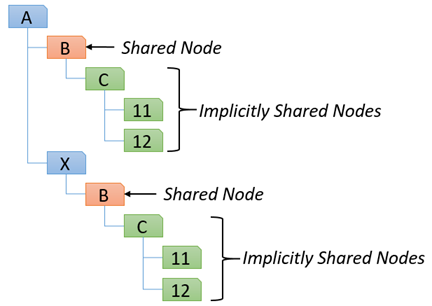Understanding Shared Nodes
Shared nodes are nodes that exist under different parents within a hierarchy set or viewpoint. Shared nodes in different positions are still the same node containing the same node-level properties like Name, Description, and Node Type. Changes made to a node-level property on a shared node affect that shared node in all of its positions.
Videos
| Your Goal | Watch This Video |
|---|---|
|
Learn more about shared nodes. |
Relationship property values are unique to a specific parent-child relationship within a hierarchy set and differ across shared nodes based on their position.
Actions you can take with shared nodes:
- Insert an existing node to make it a shared node.
- Move shared nodes to change the parent.
- Update properties.
- Remove shared nodes. When you remove a shared node, you are removing it from a specific parent. Other relationships for the node in the hierarchy set are unaffected by a remove.
- Delete shared nodes. When you delete a shared node, you are deleting it from all parents in all hierarchies. The node is also deleted from the node type for the application.
- Search for shared nodes. You can navigate between instances of a shared node when you search for nodes in a viewpoint.
- Enable and disable shared nodes. By default shared node support is enabled.
To configure shared nodes (enable and disable), see Creating Hierarchy Sets.
Implicitly Shared Nodes
Implicitly shared nodes are nodes that have the same parent in multiple locations in a hierarchy.
For example, in the diagram below, node B is a shared node because
it exists in multiple locations in a hierarchy with different parents
(A and X). Nodes C,
11, and 12 are implicitly shared because they
exist in multiple locations in the hierarchy with the same parent
(B) but with different ancestors (A and
X).

Because implicitly shared nodes also share relationships, if you make a change to the
relationship in one part of the hierarchy (such as adding, inserting, moving, or
removing a node), that change is made everywhere the implicitly shared nodes exist
in the hierarchy. For example, in the diagram above, if you remove the child node
11 from parent C under ancestor
A, that node is also removed from parent C
under ancestor X.
Since implicitly shared nodes have the same parent, defined relationship level property values for implicitly shared nodes are the same across all locations. If you change the value for a defined relationship level property in one location, the value is changed in all other locations as well.
Inherited or derived relationship level property values for implicitly shared nodes may differ across locations. See Property Inheritance and Shared Nodes and Derived Properties.